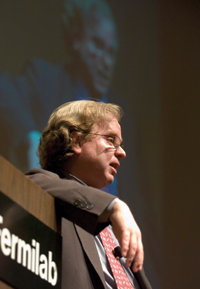Commentary: Robin Staffin
 Photo: Reidar Hahn, Fermilab |
Optimizing US high-energy physics
Whenever I have met with high-energy physicists in recent months, conversation has always turned to the charge to the High Energy Physics Advisory Panel subpanel known as P5, the Particle Physics Project Prioritization Panel, to consider the future of the two biggest US accelerator-based programs: PEP-II at SLAC and Run II of the Fermilab Tevatron Collider. In the charge letter to the subpanel, my colleague Michael Turner at NSF and I asked:
"Current planning calls for PEP-II to be operated until the end of FY2008 at the latest, and the Tevatron collider to be operated until the end of FY2009. What factors or considerations might lead to stopping B-factory operations one year, or two years earlier than planned? When would we be in a position to make such a determination and what information would be needed? Similarly, for the Tevatron collider, what factors or considerations might lead to stopping operations one year, or two years earlier than now planned? What might lead to running longer than now planned? Again, when would we be in a position to make such a determination and what information would be needed?"
To many, this charge was surprising. These are our flagship projects: Why question our plan? First, I want to emphasize that PEP-II and the Tevatron are very high priorities for the Office of Science. We have strongly invested in these world-class experiments, and look forward to their success and the exciting science that will come from them. Moreover, both facilities are running well: data is pouring in, and results are pouring out. As I heard first-hand when I attended the July Lepton Photon meeting in Uppsala, Sweden, there are intriguing hints of new physics from BaBar, and there is great reach for discovery in Run II. We have little doubt of the scientific value and vitality of these programs, and it would be a mistake to interpret this charge as implying otherwise.
We are asking P5 these questions now because we must plan our programs and investments rather far ahead. Our budgets typically start development as much as two years in advance. Even the strongest supporter of an experiment or facility recognizes that it will eventually reach a point of diminishing returns. Perhaps the luminosity can no longer be increased sufficiently to make another year of running worthwhile, or perhaps the facility is superseded by a more powerful one. The community needs to be called upon to discuss and weigh such eventualities. We are asking P5 to think about this, because we choose to plan on the basis of the best science and the best community advice, and P5 is an appropriate forum for both.
Second, we need to balance the need to get the most science from our existing investments with the need to make new investments for the future. Particle physics does not lack for future opportunities. There is the International Linear Collider, requiring significant R&D investment. On neutrino physics, the American Physical Societys study group did an excellent job of laying out the exciting science, and the Neutrino Scientific Assessment Group (NuSAG) is working to recommend a concrete set of projects in this area. We have heard about dark matter and dark energy from the Quantum Universe report, and a Dark Energy Task Force is mapping a strategy in that area.
New ideas are the fields lifeblood. In an ideal world, new ideas would stimulate the availability of new resources. And while we continue to argue for more resources, we need to be realistic, finding resources for new initiatives from what is currently invested in the field. In that context, I want and need the communitys input, through P5, on the timescale for sensible redirection.
I have gotten the message that the community cares deeply about these questions. That is exactly as it should be. I can assure you that there is no secret plan or hidden agenda. The science opportunities of PEP-II and the Tevatron are extraordinary. We are asking these questions because we really want input—your input—on the future. I have also encouraged non-US stakeholders to give me their views, and two non-US members are part of the panel. I look forward to stimulating and physics-driven discussion of the P5 process, in which I ask that you all participate.
Robin Staffin is Associate Director, High Energy Physics, in the US Department of Energys Office of Science. The full charge letter and membership of the P5 panel can be found at www.science.doe.gov/hep/hepap.shtm
Click here to download the pdf version of this article.


